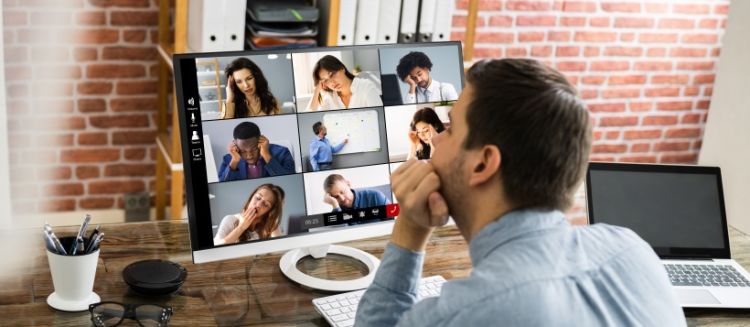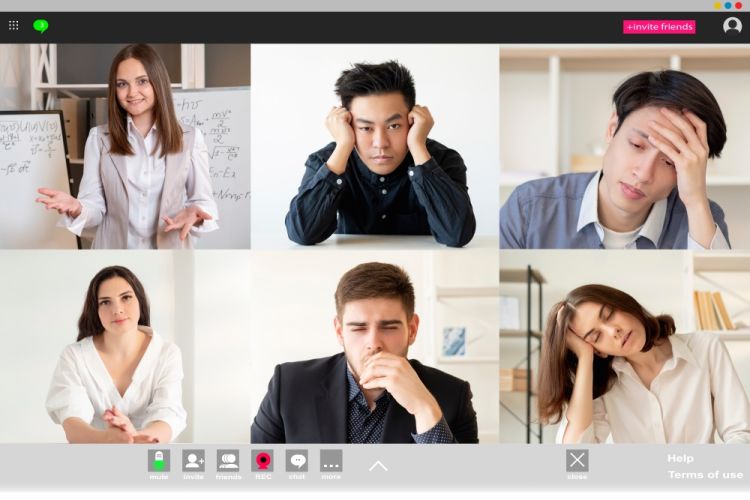Covid has driven millions onto video platforms, but should we all be doing more to keep people engaged once they are on there? Paul Milligan digs out some top tips.
Image: Shutterstock.com/Girts Ragelis
The Covid-19 pandemic has shifted the global corporate workforce from offices to home offices, which has seen usage of video platforms skyrocket. But while the platforms are simple to install and use, there is often little thought given to how to
make these daily meetings or presentations vibrant and interesting enough to keep our attention. It’s a scenario we’ve all faced over the last 18 months. You click on a webinar link thinking the broadcast will be 30 or 40 minutes long, but as you approach hour two you can feel yourself mentally checking out, you might check your emails, or have a look at social media, attention can fade very fast.
Do we all just have to accept that a proportion of our audience will fall away when using video conferencing platforms, or can we do something to improve engagement in meetings/webinars? “We should definitely not accept that's the case,” says Joel Chimoindes, vice president, Europe, for distributor Maverick AV Solutions. “Attention definitely can be retained, and improved. But what we should not do is just try to repeat what we did in a normal meeting room environment and think that it would work on video.”
Increasing engagement is a mixture of improving the technology and the environment in which we are creating content says Rory Brannigan, CEO from systems integrator ISDM. “However, it also falls on the content creators and indeed the individuals who are presenting to create something that is both lively and engaging and draws the audience in from the beginning through to the end. We must ask ourselves: Would this be engaging if my audience participants are in the room with me and if not, why not?” The problem often stems from the fact that organisers simply take a model from the real world and directly translate this into the digital world. “What they are forgetting is that there are no coffee stands or marketplaces or chill out zones for people to rest themselves,” adds Brannigan.

image: shutterstock.com/Andrey Popov
“In a virtual world people will be hunched over a laptop at a kitchen table therefore they won’t be getting access to these alternate environments that offered them the opportunity to break up their day. Therefore, an approach is needed to ensure effective translation of the in-person environment to a video collaboration space. This could mean shorter sessions, fewer PowerPoint's, more visuals, or greater audience participation.”
Could part of the problem here be we are asking Teams/Zoom/Webex to do things they just weren’t designed to do in the first place? “We are asking human beings to behave in a way that perhaps they weren’t designed for,” argues Brannigan. “We have underestimated the mental and physical impact of being with our co-workers and our customers virtually from 9:00 to 5:30 and I think this is something we need to address.”
Are there other lesser known platforms that could maybe engage us more than the ‘big 3’ maybe? Chimoindes has looked at other platforms such as Prezi to add more creativity into online presentations, but the reasons we fall back to the established video providers is because of convenience. “The reality is the Zoom/Teams/Webex platforms are part of everyday workflow for everybody, so to start using a different platform to do a presentation with when you’re living inside this environment already, is outside your workflow. Teams nor Zoom was originally designed to be a presentation or webinar platform, it was for conferencing, but you will see increased capabilities being developed in those platforms going forward.”
In order to explore other platforms and what it could offer its clients ISDM became a partner of the Quickchannel platform. It is a recording and streaming platform divided up into five core products; Base, Broadcast, Meeting, Create, and Play. Broadcast allows users to host webinars, large meetings and webcasts and you can watch the broadcast via any device, run polls and moderated chat. One especially nice feature is that it can be branded so your company name isn’t lost in the branding of the technology provider you’re hosting on.
Before a live broadcast of any kind online, how important is it to run through a checklist so you can boost your changes of visitor engagement? Brannigan suggests a checklist should contain the following in this order; Rehearse, record, get feedback, practise using the technology, always have an aim or an objective for running the webinar, and finally have a backup speaker/host/microphone/camera. While an online event may differ in delivery from an in-person event, there is no doubt a rehearsal will make for a better finished product, and one that keeps viewers engaged. Nothing is more likely to turn viewers away than the wrong video or slide appearing on the screen, or going to the wrong person when it’s someone else’s turn to speak. “By having that dry run you can make sure people are comfortable. It solves questions such as when do I need to transition this slide? When do I need to cut to a video? A lot of the time with events it’s not just a single person or a couple of people delivering it, there’s always people in the background that have to work in synchronisation with them,” says Don Lambresa, CEO of systems integrator Project Audio Visual. “A dry run will 100% give you the best chance of delivering the best experience you want to.”

Having a simple three-point checklist before you begin can make a world of difference to engagement levels says Chris Merrick, senior director, global integrated systems marketing, Shure. “Firstly, use the right equipment: companies need to ensure that the employees have all the right equipment at home - laptop, earphones or headphones with good communication capabilities, and a quiet room to work in. Second, give everyone a voice – engage participants by asking questions and letting them ask questions will ensure that they don’t feel left out. Lastly, make it simple - companies can avoid stress and frustrations with complicated practices by making sure everyone knows how to use the enabling technology.”
Length of your meeting/webinar can also be crucial to engagement levels, too long and people will start to mentally ‘wander off’, this is where having breaks in the form of breakout rooms can be so effective. A change of speaker and topic, even for five to ten minutes, can refresh viewer’s eyes and reinvigorate attendees. As Brannigan mentions above, a real-life event wouldn’t run for six or seven hours without a break, so don’t do it online.
Lighting and audio are two vital aspects to keeping/boosting engagement in online events, yet not enough is done in many events to make sure they are as good as they can be. “Lighting is crucial in keeping participants engaged and is very often get forgotten about,” says Brannigan. “If the audience cannot see you properly, it is highly likely they will lose interest and take their attention elsewhere.” Room design is often a barrier to getting appropriate lighting says Lambresa. “Most people are more interested in the aesthetics of the room than they are anything else. They’ll put kit into rooms and when we have gone in we’ve had to point out that cameras are facing out and you’ve got the window behind you with the sun shining through so it’s not going to deliver the experience you want.”
Because of the overnight shift from office to home working in March last year, the majority of workers now have to make do with the audio provided by their laptop. Which depending on the laptop’s age can veer from pretty good to pretty awful. Given that audio is the most crucial aspect of any online meeting its importance in helping engagement levels cannot be overstated, if you can’t hear someone properly you won’t hang around for long.
In the short term some audio issues have been met through increased sales of webcams with built-in mics which have improved the sonic quality. In the long-term things are looking up too says Simon Kitson, smart meetings director for Europe,
Maverick AV Solutions; “A real focus for the next 12 months will be the quality of the audio. Everybody’s sorted their platform and the PC that’s going to drive it, they’ve sorted their cameras, but now there’s definitely a desire for a better audio experience, whether that’s adding mic pods to a meet-up type solution or whether it’s adding ceiling microphones and external audio. I do think we’ll see a greater demand for higher quality audio as the next year goes on.”
After years of slow adoption, the videoconferencing sector now has the customer base it always dreamed about. What it needs now is to increase the levels of engagement in those daily meetings and webinars. The more times meetings can provide a satisfactory experience, then usage levels will remain high. To do that we have to adjust our thinking (what works in real life won’t automatically work online), think about our audience (more breaks, more interactive content) and design the spaces hosting meetings with the correct lighting and audio for that room.